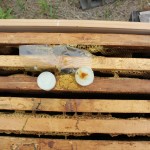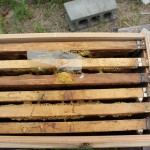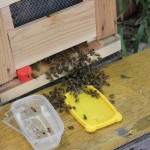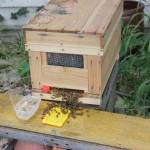Yesterday I visited a western honey bee hive on the Hakozaki Campus that is being kept by a female Taiwanese graduate student and she happened to ride up on her bicycle at the same time I arrived, so I was able to talk to her about her bees. She is doing greenhouse pollination (ecology) studies with dandelions and honey bees as pollinators. I offered to give her advice on keeping her bees healthy if she was interested. She does not seem to have much experience beekeeping.
I told her that I had noticed that the bees she had last year had died out and that she had a new hive now. I asked her where she got them from and how much they had cost. She told me she bought them from Kurume (a company I know about and have visited) and they had cost over 30,000 yen (that’s over $300 USD). That seems an awfully steep price to me but maybe that’s what they cost these days in Japan. She said that in Taiwan bees are less expensive. After they get the Spring honey crop there, they don’t need them any more (so she says) and so they sell them cheaply.
I took her over to the hive box where last year’s bees had died and opened it and showed and explained to her that the frames were spaced much too far apart and that the reason the bees died is probably because they were not able to cluster enough to keep warm during the winter. It was not until I tried to move the frames closer to one another that I noticed that they had all been nailed down into the rabbet so they could not be moved and that was the reason I was unable to slide them. As I think about it now, they were probably shipped that way originally so they would not shift around during transit and then never moved again after arriving here. She had been feeding them white sugar and what looked like an artificial pollen substitute too, and that is another reason to believe that they did not survive. I understand that white sugar and white sugar syrup will shorten bees’ lives.
I told her that if she was interested, I would be happy to look at her bees and give her advice on how to keep them healthy, but I would not do anything to them without discussing it with her first. She seemed to be interested in my offer, so I told her I would look at the new hive when I had time.
Today I decided to go take a look at them–to at least take the top cover off and check the frame spacing. I took my protective gear with me and when I tried to open the hive, I could not get the cover to budge, even prying it up with the hive tool. Finally I noticed that the top was nailed shut on either end, and I could not get the nails out using my hive tool, so I returned to my office to retrieve a claw hammer and returned to the hive once again. After removing the nails, I still could not get the lid to move. I thought it might be because of the rain and the wood might be swollen and stuck and hard to move. I finally got it to move a little bit and after quite some exertion I was able to raise the lid far enough to get a little peak inside. It was then that I could see the combs seemed to all be attached to the lid and that was why it was so hard to get off. I quickly put it back down (it was starting to rain harder now) and packed up my gear to leave.
While walking back to my office trying to make sense of what I had seen and experienced, it came to me that this hive probably came shipped just that way, all nailed shut, and she just opened the front entrance after it arrived, setting it out where it is now, but had not done anything else. I don’t know whether I might find some frames inside, nailed down too, and maybe just on one side, so the bees then built comb hanging from the lid in the open space. That is what I am guessing right now, but I don’t want to do anything else until I talk to her again and ask a few more questions. If she really wants to keep them healthy, it will take more hands on work than she has given it so far. She has been feeding them honey and pollen so they have built up.
It is going to be a real mess to get it into a workable condition, but I have some ideas on how to do it successfully. It’s too bad that I could not have become involved sooner and a lot of this mess could have been avoided. Part of me says, though, that it might be just as well to leave it alone and let it stay a non-movable single box hive that cannot be expanded or examined. Anyway, I will talk to her and tell her what I think her options are and what I would do if I were her. I should have thought to get her phone number and email address when I saw her yesterday, but I did not. I’ll have to watch for her or leave her a note.




